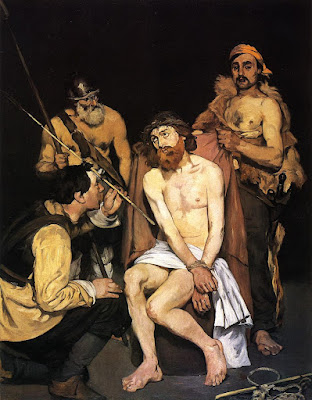 Title: Jesus Mocked by the Soldiers
Title: Jesus Mocked by the SoldiersArtist: Edouard Manet
Medium: Oil on board
Size: 190.82 x 148.27 cm
Date: 1865
Location: The Art Institute of Chicago.
19 IMAGES FROM THE 19th CENTURY: PART 10
Mark 15:16-18 The soldiers took Jesus into the governor's palace (called the Praetorium) and called all the other soldiers together. They put a purple robe on Jesus and used thorny branches to make a crown for his head. They began to call out to him, "Hail, King of the Jews!"
Manet depicts the moment when Christ’s captors mock the “king of the Jews” by crowning him with thorns and covering him with a purple robe. Unlike more traditional academic religious painting that portrays Jesus as a divine, other-worldly being, the figure here is not idealized. Jesus is depicted as human and vulnerable, awkwardly posed and un-heroic in demeanor. In fact, it is the soldiers themselves who reveal Christ’s divinity to the viewer. Far from being the torturers whose violent gestures populate art history, these are men who seem almost stunned in the presence of Christ. The torturer with the rod kneels in homage more than he readies himself for his cruel task; the fur-clad figure at the right holds Christ's cloak as if it were a royal robe. Because of its decidedly rebellious presentation of the subject, Jesus Mocked by the Soldiers was received at the 1865 Salon with an outburst of negative criticism.
Édouard Manet (January 1832 – April 1883) was a French painter. As one of the first 19th-century artists to approach modern-life subjects, he was a pivotal figure in the transition from Realism to Impressionism. His early masterworks, The Luncheon on the Grass (Le déjeuner sur l'herbe) and Olympia, engendered great controversy and served as rallying points for the young painters who would create Impressionism. Today, these are considered watershed paintings that mark the genesis of modern art. Although his own work influenced and anticipated the Impressionist style, he resisted involvement in Impressionist exhibitions, partly because he did not wish to be seen as the representative of a group identity, and partly because he preferred to exhibit at the Salon.

No comments:
Post a Comment